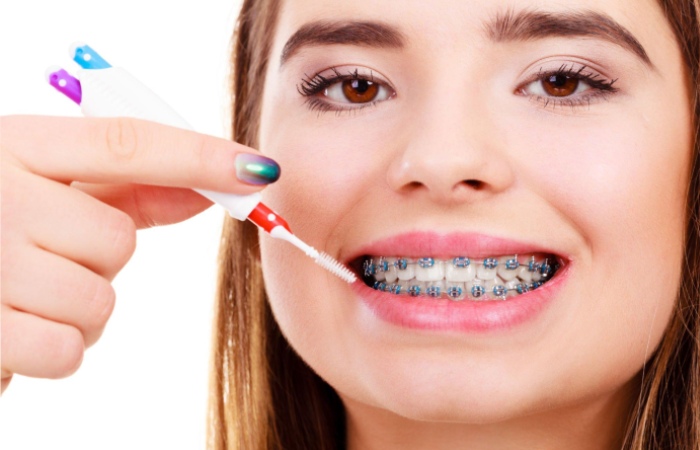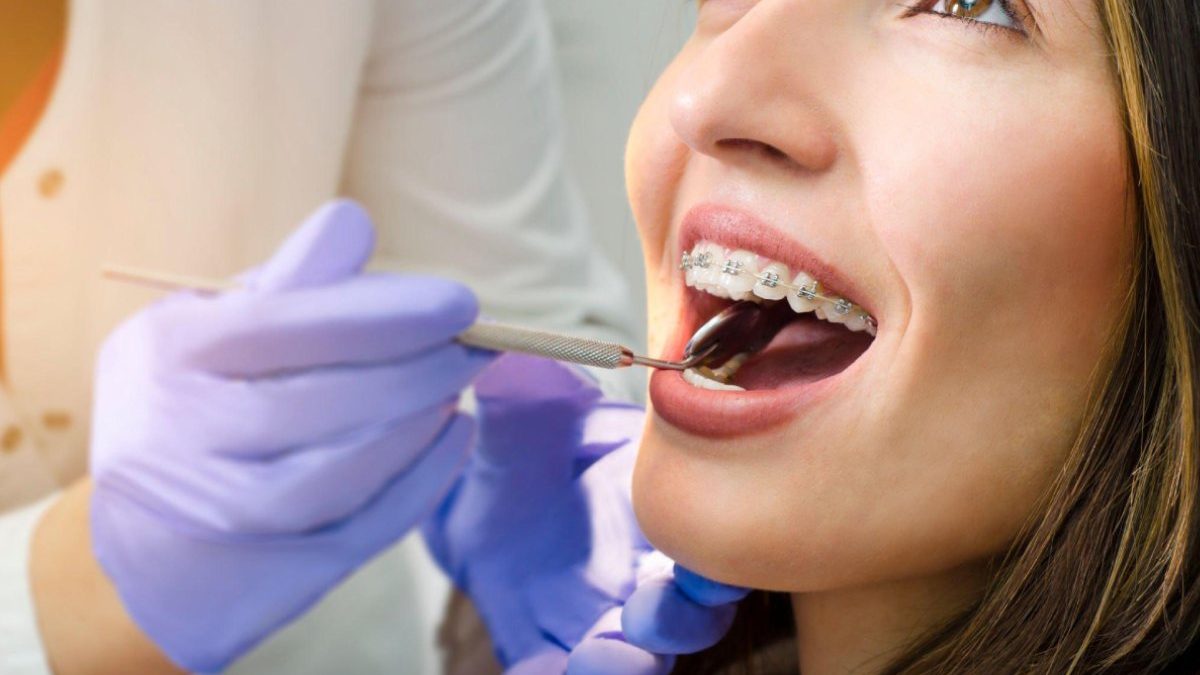Orthodontics a particular branch of dentistry that focuses on diagnosing, preventing, and treating dental and facial irregularities. Orthodontics primarily deals with correcting misaligned teeth, improper bites (malocclusions), and related issues involving the jaws and facial structures.
The goal of orthodontic treatment is to recover patients’ function, aesthetics, and overall oral health by aligning the teeth and jaws into their proper positions. Orthodontists, who are dental professionals with additional specialized training in orthodontics, responsible for planning and implementing treatment plans to achieve these objectives.
Orthodontic treatment involves using various appliances, techniques, and technologies to correct dental problems. Some common orthodontic treatments include:
Table of Contents
Braces – Orthodontics
Braces consist of brackets, wires, and bands attached to the teeth to exert gentle pressure, gradually moving them into proper alignment.
Clear Aligners
Clear aligners like Invisalign are a series of removable, transparent trays that gradually shift the teeth into their desired positions. As a result, they offer a more discreet other to traditional braces.
Retainers – Orthodontics
Retainer appliances used to maintain the corrected position of the teeth after orthodontic treatment.
Headgear – Orthodontics
Orthodontic headgear is sometimes used to modify the growth of the face and jaws, applying pressure to specific teeth or jaw areas.
Palatal Expanders
Palatal expanders are devices used to widen the upper jaw to create more space for proper teeth alignment.
Orthodontic treatment focuses on improving aesthetics and plays a significant role in promoting oral health. Properly aligned teeth are easier to clean, plummeting the risk of tooth decay, gum disease, and other dental problems. Additionally, orthodontic treatment can help improve speech, jaw function, and overall site functionality.
Individuals seeking orthodontic treatment typically undergo an initial evaluation where the orthodontist assesses their dental and facial structures, discusses treatment options, and develops a customized treatment plan base on their specific needs and goals.
What is an example of an orthodontic treatment?

An example of an orthodontic treatment is braces. Braces are a standard orthodontic treatment used to correct misaligned teeth and jaws. They consist of brackets, which are bonded to the teeth, and archwires that are threaded through the shelves. The orthodontist applies gentle pressure to the teeth by adjusting the wires over time, gradually guiding them into their desired positions.
Braces typically used to address various dental issues, including crowded teeth, gaps between teeth, overbite (where the upper teeth protrude over the lower teeth), underbite (where the lower teeth extend past the upper teeth), crossbite (when the upper and lower teeth don’t align properly), and other alignment problems. The treatment duration can vary depending on the case’s complexity, but it usually ranges from several months to a few years.
In recent years, there have remained improvements in orthodontic treatments, such as the development of clear aligners like Invisalign. These removable aligners are transparent plastic and offer a more discreet alternative to traditional braces. They work by gradually shifting the teeth into their proper positions, similar to braces, but with the advantage of being nearly invisible and more convenient for eating and oral hygiene.
Orthodontic Treatment Options
Orthodontists possess specialized knowledge to evaluate various treatment options based on age, jaw imbalances, tooth size differences, and more. They have the expertise to determine the most suitable approach and will collaborate with you to create a personalized treatment plan for achieving a customized smile.
What are Three Orthodontic Treatment Classifications?
Orthodontic treatments can be classified into three main categories: fixed appliances, removable appliances, and orthognathic surgery. Here’s an overview of each classification:
Fixed Appliances
Fixed appliances are the most common type of orthodontic treatment and often referred to as braces. They consist of brackets, bands, and wires permanently attached to the teeth. This system exerts gentle pressure on the teeth, gradually moving them into the desired positions. Braces can effectively treat dental issues, including crowded teeth, spacing problems, bite irregularities, and jaw misalignment. The brackets and wires can be made of various materials such as metal, ceramic, or a combination of both.
Removable Appliances
Removable appliances are orthodontic devices that can be taken out of the mouth. These appliances typically used for mild to moderate orthodontic corrections. Examples of removable appliances include clear aligners (e.g., Invisalign) and retainers. Clear aligners are transparent plastic trays custom-made to fit the patient’s teeth. They replaced periodically to move the teeth into the desired alignment gradually. Retainers, on the other hand, are often used after braces or other orthodontic treatments to maintain the corrected position of the teeth.
Orthognathic Surgery
In some cases, orthodontic problems caused by underlying jaw structure or skeletal alignment issues. Orthognathic or corrective jaw surgery is a treatment option for such patients. It involves surgically repositioning the jaw bones to correct the bite and facial imbalances. Orthognathic surgery is typically performed in conjunction with orthodontic treatment. The braces or other appliances help align the teeth before the surgery, and then post-surgery, orthodontic treatment continues to fine-tune the teeth alignment.
It’s significant to note that the specific treatment option recommended for an individual will depend on their unique dental condition and the assessment made by an orthodontist or oral surgeon. In addition, they will consider factors such as the severity of the issue, the patient’s age, and oral health to determine the most suitable treatment approach.
Can braces Change Face Shape?

Braces primarily focus on correcting the alignment and positioning of the teeth. While orthodontic treatment, including mounts, can indirectly affect the face shape, it typically limited to changes in the jaw and lip position rather than significant alterations in facial structure.
Here are some ways braces can potentially affect the face:
- Improved Facial Balance: Correcting dental irregularities and aligning the teeth can improve facial balance. For example, addressing issues like an overbite or underbite can help align the jaws properly, resulting in a more balanced facial appearance.
- Correction of Jaw Position: In cases where the jaw misalignment contributes to an imbalanced facial structure, orthodontic treatment may help improve the position and alignment of the jaws. This can positively impact the overall facial aesthetics.
- Changes in Lip Position: Braces can sometimes affect the position of the lips. For example, if the teeth are protruding, braces can gradually bring them back into alignment, which can influence the placement and appearance of the lips.
It’s important to note that the extent of these changes and their impact on facial appearance varies from person to person. Significant alterations to the face shape typically require more comprehensive treatment options, such as orthognathic surgery, which involves repositioning the jaw bones.
When considering orthodontic treatment, it’s crucial to consult with an experienced orthodontist or dentist who can evaluate your specific dental and facial concerns. They will be able to provide a comprehensive assessment and discuss the potential effects of orthodontic treatment on your facial structure.
Benefits of Orthodontics Treatment
Orthodontic treatment offers several benefits beyond just improving your smile’s appearance. Here are some key benefits of orthodontics:
Enhanced Aesthetics Orthodontic treatment can significantly improve the appearance of your smile by straightening crooked or misaligned teeth. This can boost your self-confidence and improve your overall facial aesthetics.
Improved Oral Health Straightening teeth through orthodontic treatment makes them easier to clean and maintain. Properly aligned teeth reduce the risk of tooth decay, gum disease, and other oral health issues. In addition, good oral hygiene becomes more effective with straight teeth, improving long-term oral health outcomes.
Corrected Bite and Jaw Alignment Orthodontic treatment can address bite problems, such as overbite, underbite, crossbite, and open bite. Fixing these issues helps improve jaw alignment and function, leading to better oral health, reduced jaw pain. And improved chewing and speaking abilities.
Alleviation of Dental Discomfort Misaligned teeth can cause discomfort and strain on the jaw joints and muscles, leading to headaches, jaw pain, and even tooth wear. Orthodontic treatment can help alleviate these symptoms by properly aligning the teeth and reducing the strain on the supporting structures.
Speech Improvement Orthodontic treatment can positively impact speech by correcting issues caused by misaligned teeth or jaws. Properly aligned teeth and jaws can improve articulation and pronunciation, enhancing speech clarity and overall communication.
Preventive Measures Orthodontic treatment can help prevent future dental problems. Aligning the teeth and jaws reduces the risk of dental trauma or injury caused by protruding or misaligned teeth. It can also prevent excessive tooth wear due to improper bite alignment.
Long-Term Investment Orthodontic treatment is a long-term investment in oral health and overall well-being. Straightening your teeth and improving your bite can have lasting effects. Providing benefits well beyond the duration of the treatment itself.
Conclusion
In conclusion, orthodontic treatment offers numerous benefits. It aligns teeth, enhances aesthetics, improves oral health, corrects bite issues, relieves discomfort, enhances speech, prevents future dental problems, and is a long-term investment in overall well-being. Therefore, consulting with an orthodontist is crucial in determining the best treatment plan for individual needs.


